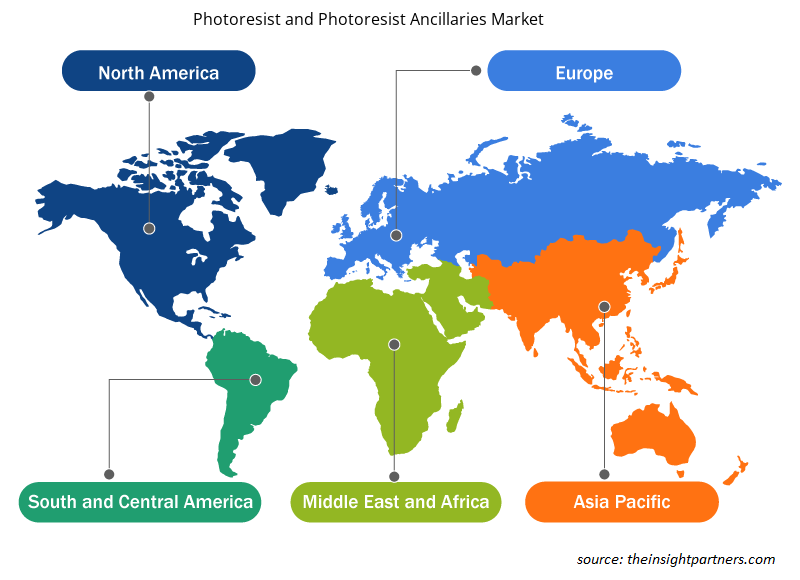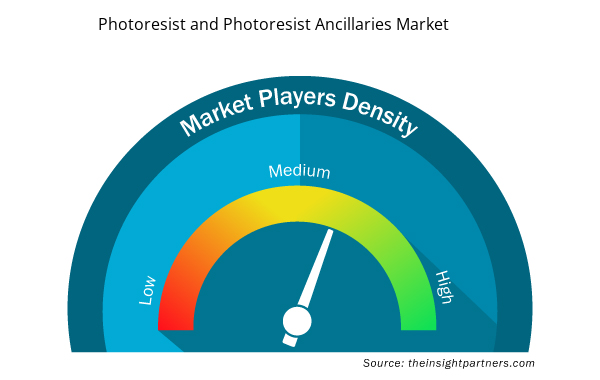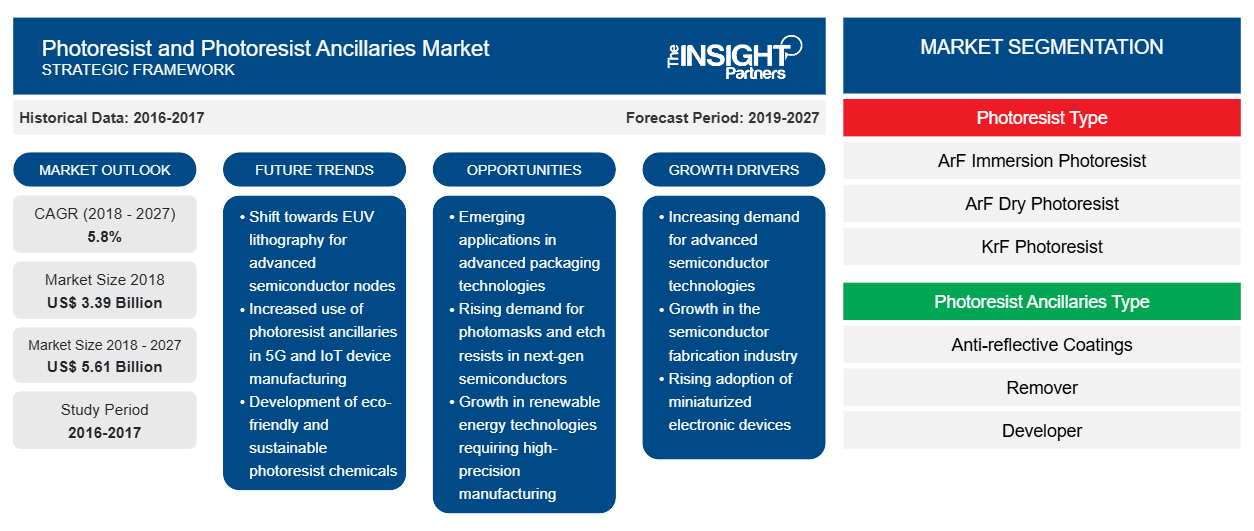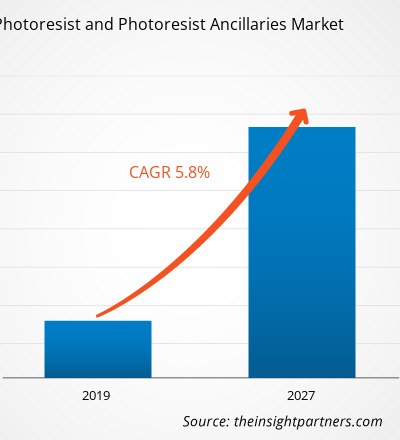El mercado de fotorresistencias y sus accesorios se valoró en US$ 3.392,97 millones en 2018 y se proyecta que alcance los US$ 5.614,37 millones para 2027; se espera que crezca a una CAGR del 5,8% entre 2019 y 2027.
Las fotorresistencias son resinas poliméricas sensibles a la luz que se utilizan principalmente en la producción de placas de circuitos impresos, placas de impresión, pantallas planas de cristal líquido, cabezales de grabación magnética y sistemas microelectromecánicos (MEMS). Estos componentes sirven como materiales de enmascaramiento para la transferencia de imágenes a un sustrato subyacente mediante procesos de grabado. Los auxiliares de las fotorresistencias son materiales como decapantes de fotorresistencias, revestimientos antirreflectantes, reveladores y eliminadores de bordes que se utilizan junto con las fotorresistencias. Las fotorresistencias y los auxiliares de las fotorresistencias se utilizan en la configuración del cableado en semiconductores multicapa para la fabricación de ordenadores, portátiles, reproductores de música, teléfonos, servidores y electrodomésticos. La industria electrónica se enfrenta a un crecimiento constante en los países desarrollados y en desarrollo. Las empresas que operan en este campo utilizan fotorresistencias y auxiliares de las fotorresistencias en la fabricación de productos como teléfonos avanzados, sistemas informáticos, televisores y equipos de entretenimiento doméstico, y dispositivos electrónicos de control y monitorización utilizados en muchas aplicaciones industriales y científicas.
Se espera que América del Norte crezca a la CAGR más alta del 6,0 % durante el período de pronóstico. Varias empresas nacionales e internacionales tienen una presencia sólida en América del Norte. Las empresas están mejorando continuamente los procesos comerciales generales para satisfacer la demanda de los clientes de la mejor manera posible. Varias empresas nacionales e internacionales tienen una presencia sólida en la región de América del Norte. En la región de América del Norte, EE. UU. es un mercado importante para la fotorresistencia y sus accesorios, seguido de Canadá y México.
El brote de COVID-19 comenzó en Wuhan (China) en diciembre de 2019 y, desde entonces, se ha extendido por todo el mundo a un ritmo rápido. China, Italia, Irán, España, la República de Corea, Francia, Alemania y los EE. UU. se encuentran entre los países más afectados en términos de casos positivos y muertes reportadas a marzo de 2020. Según las últimas cifras de la OMS, hay aproximadamente 332 930 casos confirmados y 14 510 muertes en total en todo el mundo. El brote de COVID-19 ha afectado a las economías e industrias en varios países debido a los confinamientos, las prohibiciones de viaje y los cierres de empresas. La industria química y de materiales global es una de las principales industrias que sufre graves interrupciones, como interrupciones de la cadena de suministro, cancelaciones de eventos tecnológicos y cierres de oficinas como resultado de este brote. Por ejemplo, China es el centro mundial de fabricación y el mayor proveedor de materias primas para varias industrias. El colapso general del mercado debido al COVID-19 también está afectando el crecimiento del mercado de fotorresistencia y sus auxiliares debido al cierre de fábricas, obstáculos en la cadena de suministro y recesión en la economía mundial.
Personalice este informe según sus necesidades
Obtendrá personalización en cualquier informe, sin cargo, incluidas partes de este informe o análisis a nivel de país, paquete de datos de Excel, así como también grandes ofertas y descuentos para empresas emergentes y universidades.
- Obtenga las principales tendencias clave del mercado de este informe.Esta muestra GRATUITA incluirá análisis de datos, desde tendencias del mercado hasta estimaciones y pronósticos.
Perspectivas del mercado
La creciente demanda de diversas aplicaciones ha favorecido el mercado de fotorresistencias y sus auxiliares a nivel mundial.
La creciente demanda de diversas aplicaciones, como semiconductores y circuitos integrados, pantallas LCD y placas de circuitos impresos, está impulsando el mercado de fotorresistencias y sus accesorios en todo el mundo. Uno de los factores de crecimiento clave para el mercado de fotorresistencias y sus accesorios es su uso en pantallas planas. Dado que estas pantallas son más delgadas, livianas y más eficientes energéticamente, se prefieren sobre otras pantallas, lo que estimula el crecimiento del mercado en países desarrollados y en desarrollo como Estados Unidos, Reino Unido, Italia, China, India, Rusia, Japón, México y Canadá. Además, las fotorresistencias también se utilizan en la configuración del cableado en la fabricación de semiconductores multicapa, que forman una parte clave de computadoras portátiles, computadoras, reproductores de música, teléfonos, servidores y electrodomésticos. Las fotorresistencias son resinas poliméricas sensibles a la luz que se utilizan principalmente en la producción de placas de circuitos impresos, placas de impresión, pantallas de cristal líquido de panel plano, cabezales de grabación magnética y sistemas microelectromecánicos (MEMS). Estos componentes sirven como materiales de enmascaramiento para la transferencia de imágenes a un sustrato subyacente a través de procesos de grabado. Los auxiliares de fotorresistencia son materiales tales como decapantes de fotorresistencia, recubrimientos antirreflejos, reveladores y removedores de bordes que se utilizan junto con la fotorresistencia.
Información sobre aplicaciones
Según la aplicación, el mercado de fotorresistencias y sus accesorios se segmenta en fotorresistencias de inmersión ArF, fotorresistencias secas ArF, fotorresistencias KrF y fotorresistencias de línea G e línea I. En 2018, el segmento de fotorresistencias de inmersión ArF representó la mayor participación del mercado global de fotorresistencias y accesorios de fotorresistencias; sin embargo, se espera que el segmento de fotorresistencias de línea G e línea I crezca a una CAGR más alta durante el período de pronóstico. Se consideran una excelente ventana de proceso que muestra uniformidad de dimensión crítica (CD) que permite una mejor forma del perfil del producto. Estos productos satisfacen las necesidades de la creciente cantidad de consumidores urbanos de clase media que están dispuestos a pagar un precio superior por fotorresistencias y accesorios de fotorresistencia.
Información sobre los tipos de accesorios de fotorresistencia
Según el tipo de fotorresistencia, el mercado de fotorresistencia y sus accesorios se segmenta en recubrimientos antirreflectantes, removedores, reveladores y otros. El segmento de recubrimientos antirreflectantes representó la mayor participación del mercado global de fotorresistencia y sus accesorios; sin embargo, se espera que el segmento de removedores registre la tasa de crecimiento más rápida durante el período de pronóstico. Los recubrimientos antirreflectantes se clasifican bajo el grado de producto de los accesorios de fotorresistencia que ayudan a controlar la reflexión y absorben la luz durante la fotolitografía. Se sabe que poseen varias propiedades favorables, como supresión de múltiples reflejos y mejora del contraste. Estos recubrimientos trabajan directamente en la reducción de los costos operativos de los procesos del sector electrónico. Los recubrimientos antirreflectantes ayudan a los procesos heredados de 365 nm (línea I) a los métodos de inmersión de vanguardia de 193 nm. Estos materiales ofrecen una ventana de proceso dinámica junto con una amplia compatibilidad con fotorresistencias y el patrón deseado.
Perspectivas regionales del mercado de fotorresistentes y sus accesorios
Los analistas de Insight Partners explicaron en detalle las tendencias y los factores regionales que influyen en el mercado de fotorresistencias y sus accesorios durante el período de pronóstico. Esta sección también analiza los segmentos y la geografía del mercado de fotorresistencias y sus accesorios en América del Norte, Europa, Asia Pacífico, Oriente Medio y África, y América del Sur y Central.

- Obtenga datos regionales específicos para el mercado de fotorresistencias y sus accesorios
Alcance del informe de mercado sobre fotorresistencias y sus accesorios
| Atributo del informe | Detalles |
|---|---|
| Tamaño del mercado en 2018 | US$ 3.39 mil millones |
| Tamaño del mercado en 2027 | 5.61 mil millones de dólares estadounidenses |
| Tasa de crecimiento anual compuesta (CAGR) global (2018-2027) | 5,8% |
| Datos históricos | 2016-2017 |
| Período de pronóstico | 2019-2027 |
| Segmentos cubiertos | Por tipo de fotorresistencia
|
| Regiones y países cubiertos | América del norte
|
| Líderes del mercado y perfiles de empresas clave |
|
Densidad de actores del mercado: comprensión de su impacto en la dinámica empresarial
El mercado de fotorresistencias y sus accesorios está creciendo rápidamente, impulsado por la creciente demanda de los usuarios finales debido a factores como la evolución de las preferencias de los consumidores, los avances tecnológicos y una mayor conciencia de los beneficios del producto. A medida que aumenta la demanda, las empresas amplían sus ofertas, innovan para satisfacer las necesidades de los consumidores y aprovechan las tendencias emergentes, lo que impulsa aún más el crecimiento del mercado.
La densidad de actores del mercado se refiere a la distribución de las empresas o firmas que operan dentro de un mercado o industria en particular. Indica cuántos competidores (actores del mercado) están presentes en un espacio de mercado determinado en relación con su tamaño o valor total de mercado.
Las principales empresas que operan en el mercado de fotorresistencias y sus accesorios son:
- ALLRESIST GmbH
- DJ MicroLaminates, Inc.
- DuPont de Nemours, Inc.
- Corporación FUJIFILM Holdings
- Corporación JSR
Descargo de responsabilidad : Las empresas enumeradas anteriormente no están clasificadas en ningún orden particular.

- Obtenga una descripción general de los principales actores clave del mercado de fotorresistencias y accesorios de fotorresistencia
Cobertura del informe
Mercado mundial de fotorresistencias y sus accesorios (por tipo de fotorresistencia)
- Fotorresistencia de inmersión ArF
- Fotorresistencia seca ArF
- Fotorresistencia KrF
- Fotorresistencia de línea G y línea I
Mercado mundial de fotorresistencias y sus accesorios: por tipo de fotorresistencia
- Recubrimientos antirreflejos
- Agente de mudanzas
- Revelador
- Otros
Mercado mundial de fotorresistencias y sus accesorios (por aplicación)
- Semiconductores y circuitos integrados
- Pantallas LCD
- Placas de circuito impreso
- Otros
Perfiles de empresas
- Compañía Merck KGaA
- Compañía química Sumitomo, Ltd.
- TOKIO OHKA KOGYO CO., LTD
- Tecnología de microrresistencia GmbH
- Compañía química Shin-Etsu, Ltd.
- ALLRESIST GmbH
- DJ Microlaminados, Inc.
- DuPont de Nemours, Inc.
- Corporación Fujifilm
- Corporación JSR
- Análisis histórico (2 años), año base, pronóstico (7 años) con CAGR
- Análisis PEST y FODA
- Tamaño del mercado Valor/volumen: global, regional, nacional
- Industria y panorama competitivo
- Conjunto de datos de Excel


- Batter and Breader Premixes Market
- Broth Market
- Dried Blueberry Market
- Pharmacovigilance and Drug Safety Software Market
- Power Bank Market
- Adaptive Traffic Control System Market
- Oxy-fuel Combustion Technology Market
- Artwork Management Software Market
- Educational Furniture Market
- Bioremediation Technology and Services Market

Report Coverage
Revenue forecast, Company Analysis, Industry landscape, Growth factors, and Trends

Segment Covered
This text is related
to segments covered.

Regional Scope
North America, Europe, Asia Pacific, Middle East & Africa, South & Central America

Country Scope
This text is related
to country scope.
Preguntas frecuentes
Semiconductors and ICs segment is the leading segment in the forecast period. Growth and development in semiconductor industry in terms of display technology is expected to drive the growth of photoresist and photoresist ancillaries market. Photoresist materials are being extensively used in production of semiconductors and ICs components as they imprint the required circuitry to get ICs as the end product. Photoresist and ancillaries materials are utilized in high density packaging and wiring configuration in multi-layered semiconductor production, which are considered as an crucial parts of electronic devices. They are widely being used in consumer electronics such as smart phones, music players, household appliances, etc. and in other industrial processes.
The major players operating in the global photoresist and photoresist Ancillaries market are MERCK KGaA.; Sumitomo Chemical Co., Ltd; TOKYO OHKA KOGYO CO., LTD; Micro Resist Technology GmbH.; Shin-Etsu Chemical Co., Ltd; ALLRESIST GmbH; DJ Micro laminates, Inc.; DuPont de Nemours, Inc.; Fujifilm Corporation.; and JSR Corporation; among many others.
In 2018, the photoresist and photoresist ancillaries market was predominant in Asia Pacific at the global level. The APAC encompasses an ample amount of opportunities for the growth of photoresist and photoresist ancillaries. The region has been noticed as one of the prominent markets for the utilization of photoresist and photoresist ancillaries. China is dominating the regional market, followed by other countries such as Japan, Taiwan, Vietnam, Korea, Thailand, Malaysia, and Indonesia. These countries are experiencing rising demand from the semiconductors and ICs, LCDs, printed circuit boards, and others. Apart from its application in the semiconductors industry, photoresist and photoresist ancillaries are extensively utilized in the wearable devices, smart phones, and other electronic devices. The demand for smart phones and wearable devices has increased subsequently with the growth of the electronics industry, along with a shift in consumer living standards. This shift has propelled the growth of the market in the region
Trends and growth analysis reports related to Chemicals and Materials : READ MORE..
The List of Companies - Photoresist and Photoresist Ancillaries Market
- ALLRESIST GmbH
- DJ MicroLaminates, Inc.
- DuPont de Nemours, Inc.
- FUJIFILM Holdings Corporation
- JSR Corporation
- Shin-Etsu Chemical Co., Ltd.
- Tokyo Ohka Kogyo Co., Ltd
- Micro Resist Technology GmbH
- Merck KGaA
- Sumitomo Chemical Co., Ltd.
The Insight Partners performs research in 4 major stages: Data Collection & Secondary Research, Primary Research, Data Analysis and Data Triangulation & Final Review.
- Data Collection and Secondary Research:
As a market research and consulting firm operating from a decade, we have published and advised several client across the globe. First step for any study will start with an assessment of currently available data and insights from existing reports. Further, historical and current market information is collected from Investor Presentations, Annual Reports, SEC Filings, etc., and other information related to company’s performance and market positioning are gathered from Paid Databases (Factiva, Hoovers, and Reuters) and various other publications available in public domain.
Several associations trade associates, technical forums, institutes, societies and organization are accessed to gain technical as well as market related insights through their publications such as research papers, blogs and press releases related to the studies are referred to get cues about the market. Further, white papers, journals, magazines, and other news articles published in last 3 years are scrutinized and analyzed to understand the current market trends.
- Primary Research:
The primarily interview analysis comprise of data obtained from industry participants interview and answers to survey questions gathered by in-house primary team.
For primary research, interviews are conducted with industry experts/CEOs/Marketing Managers/VPs/Subject Matter Experts from both demand and supply side to get a 360-degree view of the market. The primary team conducts several interviews based on the complexity of the markets to understand the various market trends and dynamics which makes research more credible and precise.
A typical research interview fulfils the following functions:
- Provides first-hand information on the market size, market trends, growth trends, competitive landscape, and outlook
- Validates and strengthens in-house secondary research findings
- Develops the analysis team’s expertise and market understanding
Primary research involves email interactions and telephone interviews for each market, category, segment, and sub-segment across geographies. The participants who typically take part in such a process include, but are not limited to:
- Industry participants: VPs, business development managers, market intelligence managers and national sales managers
- Outside experts: Valuation experts, research analysts and key opinion leaders specializing in the electronics and semiconductor industry.
Below is the breakup of our primary respondents by company, designation, and region:

Once we receive the confirmation from primary research sources or primary respondents, we finalize the base year market estimation and forecast the data as per the macroeconomic and microeconomic factors assessed during data collection.
- Data Analysis:
Once data is validated through both secondary as well as primary respondents, we finalize the market estimations by hypothesis formulation and factor analysis at regional and country level.
- Macro-Economic Factor Analysis:
We analyse macroeconomic indicators such the gross domestic product (GDP), increase in the demand for goods and services across industries, technological advancement, regional economic growth, governmental policies, the influence of COVID-19, PEST analysis, and other aspects. This analysis aids in setting benchmarks for various nations/regions and approximating market splits. Additionally, the general trend of the aforementioned components aid in determining the market's development possibilities.
- Country Level Data:
Various factors that are especially aligned to the country are taken into account to determine the market size for a certain area and country, including the presence of vendors, such as headquarters and offices, the country's GDP, demand patterns, and industry growth. To comprehend the market dynamics for the nation, a number of growth variables, inhibitors, application areas, and current market trends are researched. The aforementioned elements aid in determining the country's overall market's growth potential.
- Company Profile:
The “Table of Contents” is formulated by listing and analyzing more than 25 - 30 companies operating in the market ecosystem across geographies. However, we profile only 10 companies as a standard practice in our syndicate reports. These 10 companies comprise leading, emerging, and regional players. Nonetheless, our analysis is not restricted to the 10 listed companies, we also analyze other companies present in the market to develop a holistic view and understand the prevailing trends. The “Company Profiles” section in the report covers key facts, business description, products & services, financial information, SWOT analysis, and key developments. The financial information presented is extracted from the annual reports and official documents of the publicly listed companies. Upon collecting the information for the sections of respective companies, we verify them via various primary sources and then compile the data in respective company profiles. The company level information helps us in deriving the base number as well as in forecasting the market size.
- Developing Base Number:
Aggregation of sales statistics (2020-2022) and macro-economic factor, and other secondary and primary research insights are utilized to arrive at base number and related market shares for 2022. The data gaps are identified in this step and relevant market data is analyzed, collected from paid primary interviews or databases. On finalizing the base year market size, forecasts are developed on the basis of macro-economic, industry and market growth factors and company level analysis.
- Data Triangulation and Final Review:
The market findings and base year market size calculations are validated from supply as well as demand side. Demand side validations are based on macro-economic factor analysis and benchmarks for respective regions and countries. In case of supply side validations, revenues of major companies are estimated (in case not available) based on industry benchmark, approximate number of employees, product portfolio, and primary interviews revenues are gathered. Further revenue from target product/service segment is assessed to avoid overshooting of market statistics. In case of heavy deviations between supply and demand side values, all thes steps are repeated to achieve synchronization.
We follow an iterative model, wherein we share our research findings with Subject Matter Experts (SME’s) and Key Opinion Leaders (KOLs) until consensus view of the market is not formulated – this model negates any drastic deviation in the opinions of experts. Only validated and universally acceptable research findings are quoted in our reports.
We have important check points that we use to validate our research findings – which we call – data triangulation, where we validate the information, we generate from secondary sources with primary interviews and then we re-validate with our internal data bases and Subject matter experts. This comprehensive model enables us to deliver high quality, reliable data in shortest possible time.


 Obtenga una muestra gratuita de este informe
Obtenga una muestra gratuita de este informe